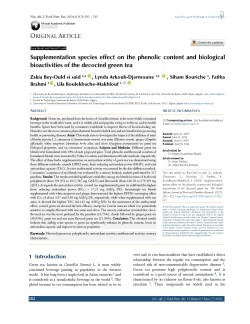Supplementation species effect on the phenolic content and biological bioactivities of the decocted green tea
Abstract
Background: Green tea, produced from the leaves of Camellia sinensis, is the most widely consumed beverage in the world after water, and it is widely sold and popular owing to its flavor, and its health benefits. Spices have been used by consumers worldwide to improve flavors of food including tea. Phenolics are the most common phytochemical found in herbal teas and are beneficial in promoting health or preventing diseases.
Aims: This study aims to investigate the impact of the addition of mint (Mentha piperita L.), cinnamon (Cinnamomum verum), star anise (Illicium verum), ginger (Zingiber officinale), white mugwort (Artemisia herba alba) and clove (Syzygium aromaticum) on green tea biological properties, and on consumers’ acceptance.
Subjects and Methods: Different green tea blends were formulated with 10% of each proposed spice. Total phenolic and flavonoid contents of formulated blends were measured by Folin-Ciocalteu and aluminum chloride methods, respectively. The effect of these herbs supplementation on antioxidant activity of green tea was determined using three different methods, namely DPPH assay, ferric reducing antioxidant power (FRAP), and total antioxidant capacity (TAC). In vitro antibacterial activity was assessed by the disc-diffusion method. Consumers’ acceptance of tea blends was evaluated by a sensory hedonic analysis performed by 127 panelists.
Results: The results revealed significant variability among tea blends in terms of both total polyphenols (from 591.951 to 1027.387 mg GAE/L) and flavonoids (from 140.78 to 279.329 mg QE/L). As regards the antioxidant activity, control (no supplemented) green tea exhibited the highest ferric reducing antioxidant power (RC0.5 = 27.25 mg AAE/g DE). Interestingly tea blends supplemented with white mugwort and ginger demonstrated the highest DPPH• scavenging effect with IC50 of about 3.37 and 3.38 mg AAE/g DE, respectively, while when supplemented with star anise, it showed the highest TAC (66.143 mg AAE/g DE). In the assessment of the antibacterial effect, control green tea showed the best efficacy, except for Listeria innocua which was particularly sensitive to samples flavored with star anise and clove. The sensory evaluation revealed that clove-flavored tea was the most preferred by the panelists (31.75%), closely followed by ginger green tea (30.95%), green tea and star anise flavored green tea (25.39%).
Conclusion: The obtained results indicate that adding some species to green tea significantly enhance its phenolic content, boost its antioxidant capacity and improve its sensory properties.
Keywords: Flavored green tea; polyphenols; antioxidant activity; antibacterial activity; sensory characteristic.
Full text article
Authors
Copyright (c) 2024 Zakia Bey-Ould si Said, Lynda Arkoub-Djermoune , Siham Bouriche , Fatiha Brahmi, Lila Boulekbache-Makhlouf

This work is licensed under a Creative Commons Attribution 4.0 International License.
-
Attribution — You must give appropriate credit, provide a link to the license, and indicate if changes were made. You may do so in any reasonable manner, but not in any way that suggests the licensor endorses you or your use.
-
No additional restrictions — You may not apply legal terms or technological measures that legally restrict others from doing anything the license permits.





